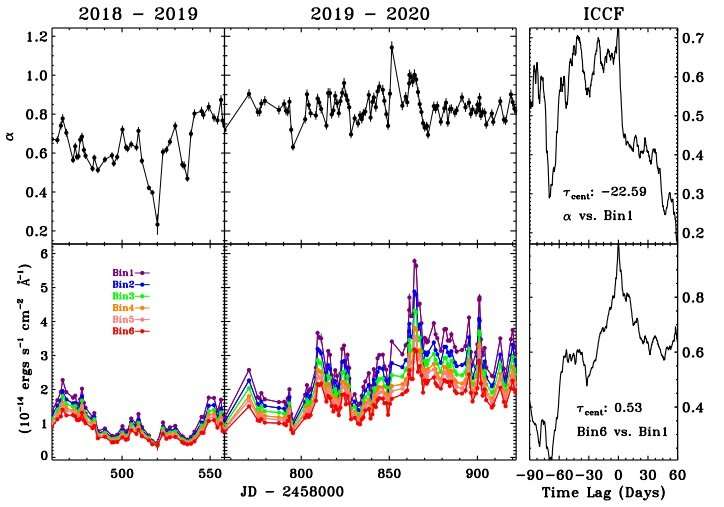September 2, 2020 report
Chinese astronomers investigate spectral behavior of gamma-ray blazar S5 0716+714

Using the Lijiang Observatory, astronomers from the Chinese Academy of Sciences (CAS) have inspected a gamma-ray blazar known as S5 0716+714. The observations provided important insights into the spectral behavior of this source, finding that it is brightness-dependent. The study was published August 26 on the arXiv.org preprint repository.
Blazars are very compact quasars associated with supermassive black holes at the centers of active, giant elliptical galaxies, and can exhibit variability on a wide range of timescales. They belong to a larger group of active galaxies that host active galactic nuclei (AGN), and their characteristic features are relativistic jets pointed almost exactly toward the Earth.
Based on their optical emission properties, astronomers divide blazars into two classes: flat-spectrum radio quasars (FSRQs) that feature prominent and broad optical emission lines, and BL Lacertae objects (BL Lacs), which do not.
S5 0716+714 is a typical BL Lac exhibiting extreme variability and a prominent relativistic jet. Previous observations of this object have suggested that it showcases the so-called bluer-when-brighter (BWB) chromatic trend. The BWB chromatism, perceived as an evidence of physical processes in jets, is one of the most common phenomena in BL Lacs. In the case of S5 0716+714, its BWB trends may depend on the brightness, for instance, the correlations at the bright state are weaker than those at the faint state.
In order to further investigate the BWB trends in this blazar, a group of astronomers led by Hai-Cheng Feng of Yunnan Observatories, China, conducted spectroscopic observations of the source with Lijiang Observatory's 2.4-m optical telescope.
"In this paper, we present the spectroscopic monitoring results of S5 0716+714, which exhibit a significantly brightness-dependent BWB trend," the astronomers wrote in the paper.
Feng's team monitored S5 0716+714 during two observation periods (Epoch1 and Epoch2) between 2018 and 2020. In general, the source was observed to show a strong BWB trend, and the correlation between brightness and spectral index was found to become weaker toward the blazar's brighter state.
According to the study, the data reveal an extremely bright state of S5 0716+714 at Epoch2, and it seems that the BWB trend becomes saturated at the highest state during this observation period. It was noted that the BWB trend of Epoch2 differs significantly from that of the Epoch1.
Trying to explain the spectral behavior of S5 0716+714, the astronomers assume that it may be a result of magnetic field amplification due to the turbulence generated in the post-shock region. They added that the BWB trend in this blazar is seemingly dominated by the relative position changes of the synchrotron peak frequency with respect to the observational frequency range, and effectively may be controlled by the variations of electron average energy and magnetic field in the emitting region.
More information: Feng et al., Spectroscopic Monitoring of Blazar S5 0716+714: Brightness-Dependent Spectral Behavior, arXiv:2008.11341 [astro-ph.HE] arxiv.org/abs/2008.11341
© 2020 Science X Network



















